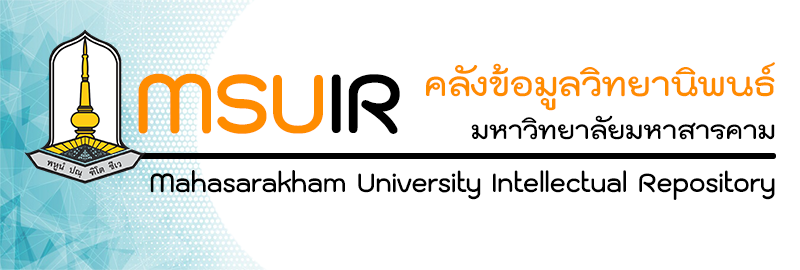Please use this identifier to cite or link to this item:
http://202.28.34.124/dspace/handle123456789/2733Full metadata record
| DC Field | Value | Language |
|---|---|---|
| dc.contributor | Lin Zhang | en |
| dc.contributor | Lin Zhang | th |
| dc.contributor.advisor | Metta Sirisuk | en |
| dc.contributor.advisor | เมตตา ศิริสุข | th |
| dc.contributor.other | Mahasarakham University | en |
| dc.date.accessioned | 2025-05-07T11:29:51Z | - |
| dc.date.available | 2025-05-07T11:29:51Z | - |
| dc.date.created | 2024 | |
| dc.date.issued | 30/5/2024 | |
| dc.identifier.uri | http://202.28.34.124/dspace/handle123456789/2733 | - |
| dc.description.abstract | Jingdezhen is a famous ceramic production and cultural center in China, with a long history of ceramic manufacturing. According to historical records, pottery was made in Jingdezhen during the Eastern Han Dynasty. Through the following three objectives: 1) To study the history, development and local wisdom of Jingdezhen ceramics from the Song Dynasty to the Qing Dynasty; 2) To Study and analyze Chinese Buddhist symbols from the perspective of semiotics; 3) To create contemporary ceramic works inspired by local wisdom and Chinese Buddhist symbols. Based on theoretical research and field investigation, combined with the current research situation in China, the author enumerates current cases of creation and analyzes the significance of applying innovative Buddhist patterns to contemporaryceramics in Jingdezhen. For the increasingly developed ceramics, there are some cases in which traditional Buddhist patterns are applied to ceramics, but there are few innovations, the theory is still relatively backward, and no systematic theoretical framework has been formed. Through the study of relevant literature and papers, I have learned that many researchers have expressed their views on Buddhist element patterns from different angles. Most of these are the descriptions of the evolution process and cultural connotation of Buddhist element patterns through dynasties. Specifically, the application of ceramic Buddhist element patterns in design art is relatively rare, and most of them are gradually distant from the Buddhist origin. Although they have been applied in different fields of modern design, they are relatively scattered and lack systematic theoretical generalization, which requires further exploration and sorting. How to combine Buddhist elements with the design of contemporary ceramics in Jingdezhen to make them more artistic value and cultural charm, and how to integrate Buddhist elements patterns into the innovative design of ceramics can also represent the attitude of pottery workers in this era towards cultural transmission and inheritance. The combination of Chinese Buddhist elements pattern and Jingdezhen contemporary ceramic design is a reflection on how traditional artifacts needed in the inheritance of Chinese culture can enter modern life, which is a kind of cultural inheritance and a manifestation of self-confidence in traditional culture. | en |
| dc.description.abstract | - | th |
| dc.language.iso | en | |
| dc.publisher | Mahasarakham University | |
| dc.rights | Mahasarakham University | |
| dc.subject | Chinese Buddhist elements | en |
| dc.subject | Jingdezhen ceramic technolog | en |
| dc.subject | Contemporary ceramics | en |
| dc.subject | Jingdezhen CHINA | en |
| dc.subject.classification | Arts and Humanities | en |
| dc.subject.classification | Activities of households as employers; undifferentiated goods- and services-producing activities of households for own use | en |
| dc.title | Contemporary ceramic art creation with Buddhist Symbols: Local wisdom and ceramic development in Jingdezhen | en |
| dc.title | Contemporary ceramic art creation with Buddhist Symbols: Local wisdom and ceramic development in Jingdezhen | th |
| dc.type | Thesis | en |
| dc.type | วิทยานิพนธ์ | th |
| dc.contributor.coadvisor | Metta Sirisuk | en |
| dc.contributor.coadvisor | เมตตา ศิริสุข | th |
| dc.contributor.emailadvisor | sakboworn.t@msu.ac.th | |
| dc.contributor.emailcoadvisor | sakboworn.t@msu.ac.th | |
| dc.description.degreename | Doctor of Philosophy (Ph.D.) | en |
| dc.description.degreename | ปรัชญาดุษฎีบัณฑิต (ปร.ด.) | th |
| dc.description.degreelevel | Doctoral Degree | en |
| dc.description.degreelevel | ปริญญาเอก | th |
| dc.description.degreediscipline | สำนักงานเลขา | en |
| dc.description.degreediscipline | สำนักงานเลขา | th |
| Appears in Collections: | Faculty of Fine - Applied Arts and Cultural Science | |
Files in This Item:
| File | Description | Size | Format | |
|---|---|---|---|---|
| 64012465013.pdf | 9.85 MB | Adobe PDF | View/Open |
Items in DSpace are protected by copyright, with all rights reserved, unless otherwise indicated.

